The Regional and Local Scale Evolution of the Spatial Structure of High-Speed Railway Networks—A Case Study Focused on Beijing-Tianjin-Hebei Urban Agglomeration
Abstract
1. Introduction
2. Literature Review
2.1. Research on Geographic Network
2.2. Research on HSR Networks and Urban Agglomerations
2.3. Research on HSR Networks at Multiple Scales
3. Materials and Methods
3.1. Study Area and HSR in Beijing-Tianjin-Hebei Urban Agglomeration
3.2. Virtual Passenger Flow Model
3.3. Complex Network Analysis
3.3.1. Measuring the Position of HSR Stations
3.3.2. Community Division Based on HSR Stations
3.3.3. Measurement of the Connection Potential between HSR Stations
3.3.4. Measurement of the HSR Network Structure
- (1)
- The Average Weighted Aggregation Coefficient
- (2)
- The Average Shortest Path Length
4. Results
4.1. The Regional Scale HSR Spatial Structure for Beijing-Tian-Hebei
4.1.1. Position of the Stations in the HSR Network
4.1.2. Community Structure for the HSR Network
4.1.3. Spatial Structure of the Connection Potential for HSR Stations
4.2. The Local Scale HSR Network Structure for Cities That Include Core Stations
5. Discussion
6. Conclusions
Author Contributions
Funding
Data Availability Statement
Acknowledgments
Conflicts of Interest
References
- Wang, S.J.; Wang, J.Y.; Liu, X.P. How do urban spatial structures evolution in the HSR era? Case study of Yangtze River Delta, China. Habitat Int. 2019, 93, 102051. [Google Scholar] [CrossRef]
- Mu, B.; Mayer, A.L.; He, R.Z.; Tian, G.H. Land use dynamics and policy implications in central china: A case study of Zhengzhou. Cities 2016, 58, 39–49. [Google Scholar] [CrossRef]
- Cornet, Y.; Dudley, G.; Banister, D. High Speed Rail: Implications for carbon emissions and biodiversity. Case Stud. Transp. Policy 2018, 6, 376–390. [Google Scholar] [CrossRef]
- Guo, Y.; Li, B.; Han, Y.L. Dynamic network coupling between HSR development and urban growth in emerging economies: Evidence from China. Cities 2020, 105, 102845. [Google Scholar] [CrossRef]
- Liang, Y.T.; Zhou, K.Y.; Li, X.; Zhou, Z.K.; Sun, W.; Zeng, J.Q. Effectiveness of high-speed railway on regional economic growth for less developed areas. J. Transp. Geogr. 2020, 82, 102621. [Google Scholar] [CrossRef]
- Wang, L.; Duan, X.J. High-speed rail network development and winner and loser cities in megaregions: The case study of Yangtze River Delta, China. Cities 2018, 83, 71–82. [Google Scholar] [CrossRef]
- Wei, S.; Jiao, J.J.; Wang, L.; Xu, L. Evolving Characteristics of HSRway Network Structure in Yangtze River Delta, China: The Perspective of Passenger Flows. Appl. Spat. Anal. Policy 2020, 13, 925–943. [Google Scholar] [CrossRef]
- Zhang, W.Y.; Derudder, B.; Wang, J.H.; Witlox, F. Approximating actual flows in physical infrastructure networks: The case of the Yangtze River Delta high-speed railway network. Bull. Geogr. Socio-Econ. Ser. 2016, 31, 145–160. [Google Scholar] [CrossRef][Green Version]
- Li, T.; Zhang, W.Y.; Cao, X.S.; Wang, L.; Zhang, L. Analyzing intercity railways network in the Pearl River Delta: A comparative study based on connections, capacity and actual flow. Geogr. Res. 2019, 38, 2730–2744. [Google Scholar]
- Wei, S.; Yuan, J.F.; Xu, J.G.; Jiang, H.B.; Jiang, J.L.; Ma, H.T. Analysis on Space-time Distribution Characteristics of Passenger Flow along Beijing-Shanghai HSR way Stations. Areal Res. Dev. 2018, 37, 54–57. [Google Scholar]
- Zhu, X.H.; Peng, T.; Chen, J.Y. Impact of strategic and critical metals trade network characteristics on the upgrading of industrial stuctures. Resour. Sci. 2020, 42, 1489–1503. [Google Scholar]
- Newman, M.E. Analysis of weighted networks. Phys. Rev. E 2004, 70, 056131. [Google Scholar] [CrossRef]
- Blondel, V.D.; Guillaume, J.L.; Lambiotte, R.; Lefebvre, E. Fast unfolding of communities in large networks. J. Stat. Mech. Theory Exp. 2008, 10, P10008. [Google Scholar] [CrossRef]
- Barrat, A.; Barthelemy, M.; Vespignani, A. Modeling the evolution of weighted networks. Phys. Rev. E 2004, 70, 066149. [Google Scholar] [CrossRef] [PubMed]
- Liu, S.Z.; Han, Z.L.; Guo, J.K. The Impact of High Speed Railway on Urban Network Structure in Northeast China. Sci. Geogr. Sin. 2020, 40, 270–279. [Google Scholar]
- Chidubem, I.; Gavin, M. A Transfer Learning Paradigm for Spatial Networks. In Proceedings of the 34th ACM/SIGAPP Symposium on Applied Computing, Limassol, Cyprus, 8–12 April 2019; Association for Computing Machinery: Limassol, Cyprus, 2019; pp. 659–666. [Google Scholar] [CrossRef]
- Yang, X.P.; Lu, S.W.; Zhao, W.F.; Zhao, Z.W. Exploring the Characteristics of an Intra-Urban Bus Service Network: A Case Study of Shenzhen, China. ISPRS Int. J. Geo-Inf. 2019, 8, 486. [Google Scholar] [CrossRef]
- Zhong, L.N.; Sun, S.; Law, R.; Yang, L.Y. Investigate Tourist Behavior through Mobile Signal: Tourist Flow Pattern Exploration in Tibet. Sustainability 2020, 12, 9125. [Google Scholar] [CrossRef]
- Ahn, J.; Seo, D.; Kwon, Y.-S. Impact of Innovation City Projects on National Balanced Development in South Korea: Identifying Regional Network and Centrality. ISPRS Int. J. Geo-Inf. 2021, 10, 169. [Google Scholar] [CrossRef]
- Liu, Y.W.; Liao, W. Spatial Characteristics of the Tourism Flows in China: A Study Based on the Baidu Index. ISPRS Int. J. Geo-Inf. 2021, 10, 378. [Google Scholar] [CrossRef]
- Zhang, P.F.; Zhao, Y.Y.; Zhu, X.H.; Cai, Z.W.; Xu, J.X.; Shi, S. Spatial structure of urban agglomeration under the impact of HSRway construction: Based on the social network analysis. Sustain. Cities Soc. 2020, 62, 102404. [Google Scholar] [CrossRef]
- Meng, D.Y.; Feng, X.H.; Wen, Y.Z. Urban network structure evolution and organizational pattern in Northeast China from the perspective of railway passenger transport. Geogr. Res. 2017, 36, 1339–1352. [Google Scholar]
- Jiao, J.J.; Wang, J.E.; Jin, F.J.; Wang, H. Impact of HSR on inter-city network based on the passenger train network in China, 2003–2013. Acta Geogr. Sin. 2016, 71, 265–280. [Google Scholar]
- Yang, H.R.; Dobruszkes, F.; Wang, J.E.; Dijst, M.; Witte, P. Comparing China’s urban systems in high-speed railway and airline networks. J. Transp. Geogr. 2018, 68, 233–244. [Google Scholar] [CrossRef]
- You, Y.Y.; Yang, H.R.; Wang, J.E. The structure evolution of China’s urban networks from the perspective of HSR flows. World Reg. Stud. 2020, 29, 773–780. [Google Scholar]
- Wei, S.; Teng, S.Q.; Li, H.J.; Xu, J.G.; Ma, H.T.; Luan, X.L.; Yang, X.J.; Shen, D.; Liu, M.S.; Huang, Z.Y.X.; et al. Hierarchical structure in the world’s largest HSR network. PLoS ONE 2019, 14, e0211052. [Google Scholar] [CrossRef]
- Xu, J.; Zhang, M.; Zhang, X.L.; Wang, D.; Zhang, Y.N. How does city-cluster HSR facilitate regional integration? Evidence from the Shanghai-Nanjing corridor. Cities 2019, 85, 83–97. [Google Scholar] [CrossRef]
- Diao, M. Does growth follow the rail? The potential impact of HSR on the economic geography of China. Transp. Res. Part A Policy Pract. 2018, 113, 279–290. [Google Scholar] [CrossRef]
- Yang, H.R.; Dijst, M.; Witte, P.; Ginkel, H.V.; Yang, W.L. The spatial structure of high speed railways and urban networks in China: A Flow Approach. Tijdschr. Voor Econ. Soc. Geogr. 2017, 109, 109–128. [Google Scholar] [CrossRef]
- Yang, X.L.; Wang, R.; Guo, D.M.; Sun, W.Z. The reconfiguration effect of China’s high-speed railway on intercity connection—A study based on media attention index. Transp. Policy 2020, 95, 47–56. [Google Scholar] [CrossRef]
- Liu, D.J.; Chen, J.Z.; Jia, Y.Y. Characteristic of tourist flow network in Chengdu-Chongqing urban agglomeration under the influence of HSR way. World Reg. Stud. 2020, 29, 549–556. [Google Scholar]
- Wang, F.; Wei, X.J.; Liu, J.; He, L.Y.; Gao, M.N. Impact of HSR on population mobility and urbanisation: A case study on Yangtze River Delta urban agglomeration, China. Transp. Res. Part A Policy Pract. 2019, 127, 99–114. [Google Scholar] [CrossRef]
- Jiao, J.J.; Wang, J.E.; Jin, F.J. Impacts of HSR lines on the city network in China. J. Transp. Geogr. 2017, 60, 257–266. [Google Scholar] [CrossRef]
- Shaw, S.L.; Fang, Z.X.; Lu, S.W.; Tao, R. Impacts of high speed rail on railroad network accessibility in China. J. Transp. Geogr. 2014, 40, 112–122. [Google Scholar] [CrossRef]
- Zheng, S.Q.; Kahn, M.E. China’s bullet trains facilitate market integration and mitigate the cost of megacity growth. Proc. Natl. Acad. Sci. USA 2013, 110, E1248–E1253. [Google Scholar] [CrossRef]
- Wei, S.; Xu, J.G.; Ma, H.T. Structural characteristics and formation mechanism of HSR network in Yangtze River Delta. Resour. Environ. Yangtze Basin 2019, 28, 739–746. [Google Scholar]
- Jin, F.J.; Jiao, J.J.; Qi, Y.J.; Yang, Y. Evolution and geographic effects of HSR in East Asia: An accessibility approach. J. Geogr. Sci. 2017, 27, 515–532. [Google Scholar] [CrossRef]
- Huang, Y.P.; Lu, S.W.; Yang, X.P.; Zhao, Z.Y. Exploring railway network dynamics in China from 2008 to 2017. ISPRS Int. J. Geo-Inf. 2018, 7, 320. [Google Scholar] [CrossRef]
- Derudder, B.; Liu, X.; Kunaka, C.; Roberts, M. The connectivity of South Asian cities in infrastructure networks. J. Maps 2014, 10, 47–52. [Google Scholar] [CrossRef]
- Derudder, B.; Witlox, F. An appraisal of the use of airline data in assessing the world city network: A research note on data. Urban Stud. 2005, 42, 2371–2388. [Google Scholar] [CrossRef]
- Derudder, B.; Witlox, F. The impact of progressive liberalization on the spatiality of airline networks: A measurement framework based on the assessment of hierarchical differentiation. J. Transp. Geogr. 2009, 17, 276–284. [Google Scholar] [CrossRef]
- Derudder, B.; Witlox, F.; Taylor, P.U.S. cities in the World City network: Comparing their positions using global origins and destinations of airline passengers. Urban Geogr. 2013, 28, 74–91. [Google Scholar] [CrossRef]
- Taylor, P.; Derudder, B. World City Network: A Global Urban Analysis, 2nd ed.; Routledge: London, UK, 2015. [Google Scholar]
- Wang, J.E.; Du, D.L.; Jin, F.J. Comparison of spatial structure and linkage systems and geographic constraints: A perspective of multiple traffic flows. Acta Geogr. Sin. 2019, 74, 2482–2494. [Google Scholar]
- Huang, Y.; Zong, H.M. The spatial distribution and determinants of China’s high-speed train services. Transp. Res. Part A Policy Pract. 2020, 142, 56–70. [Google Scholar] [CrossRef]
- Niu, F.Q.; Xin, Z.L.; Sun, D.Q. Urban land use effects of high-speed railway network in China: A spatial spillover perspective. Land Use Policy 2021, 105, 105417. [Google Scholar] [CrossRef]
- Jiao, J.J.; Wang, J.E.; Zhang, F.N.; Jin, F.J.; Liu, W. Roles of accessibility, connectivity and spatial interdependence in realizing the economic impact of high-speed rail: Evidence from China. Transp. Policy 2020, 91, 1–15. [Google Scholar] [CrossRef]
- Wang, L.; Acheampong, R.A.; He, S.W. HSR network development effects on the growth and spatial dynamics of knowledge-intensive economy in major cities of China. Cities 2020, 105, 102772. [Google Scholar] [CrossRef]
- Liu, S.L.; Wan, Y.L.; Zhang, A.M. Does China’s high-speed rail development lead to regional disparities? A network perspective. Transp. Res. Part A Policy Pract. 2020, 138, 299–321. [Google Scholar] [CrossRef]
- Wei, S. A Passenger Flow Analysis Model Based on the Remaining Ticket Information of High-speed Rail. Geomat. Spat. Inf. Technol. 2017, 40, 120–125. [Google Scholar]
- Ge, J.P.; Wang, X.B.; Guan, Q.; Li, W.H.; Zhu, H.; Yao, M. World rare earths trade network: Patterns, relations and role characteristics. Resour. Policy 2016, 50, 119–130. [Google Scholar] [CrossRef]
- Yang, C.M.; Wang, Y.J. The Community Discovery Algorithm Analysis on Weight Complex Network based on Modularity Optimization. J. Southwest Univ. Sci. Technol. 2016, 31, 84–89. [Google Scholar]
- Lee, H. The network ability of cities in the international air passenger flows 1992–2004. J. Transp. Geogr. 2009, 17, 166–175. [Google Scholar] [CrossRef]
- Xia, R. Research on the Characteristics and Evolution of Complex Network of International LNG Trade. Master’s Thesis, Dalian Maritime University, Dalian, China, 2020. [Google Scholar]
- Wang, J.E.; Mo, H.H.; Wang, F.H. Evolution of air transport network of China 1930–2012. J. Transp. Geogr. 2014, 40, 145–158. [Google Scholar] [CrossRef]
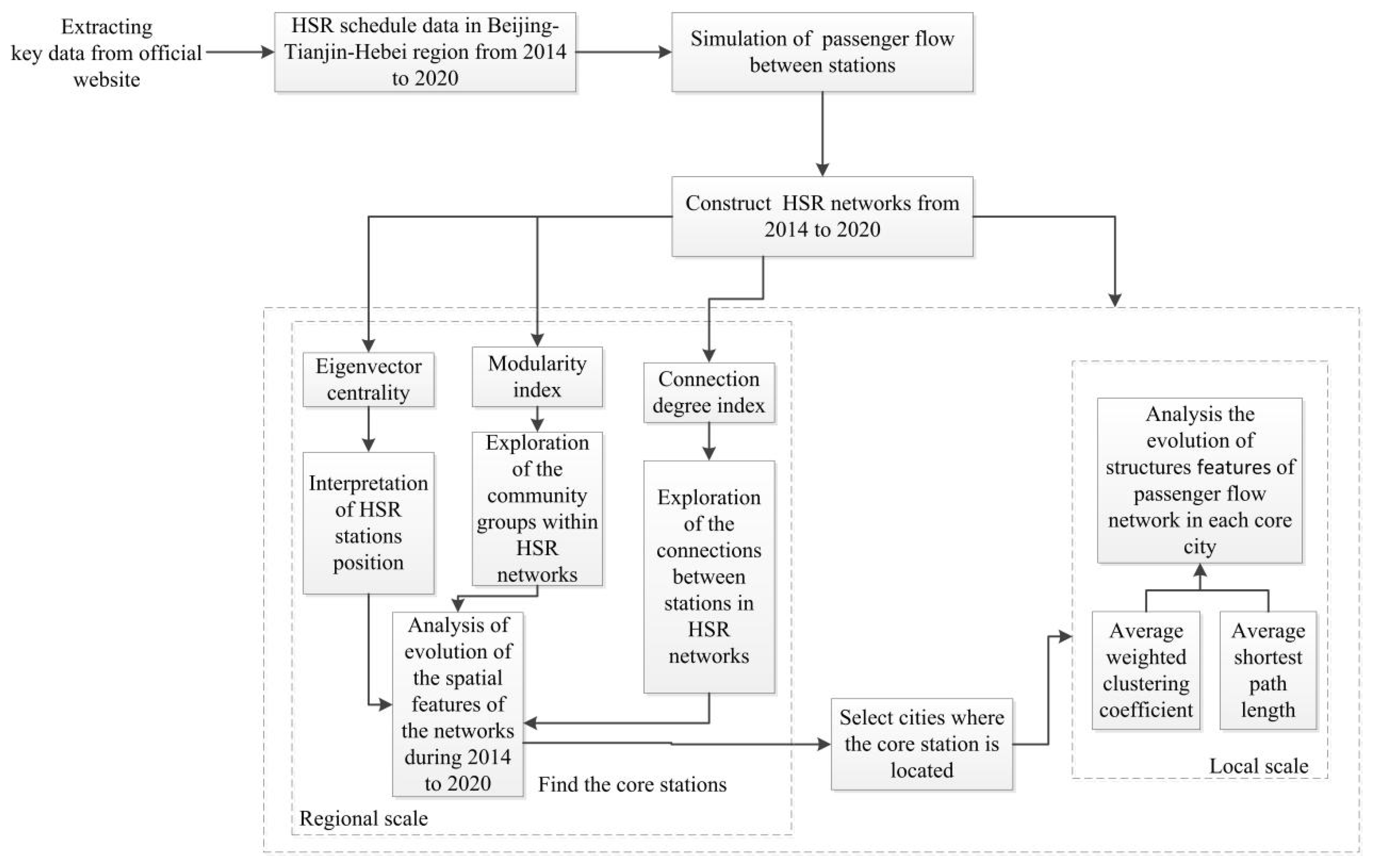
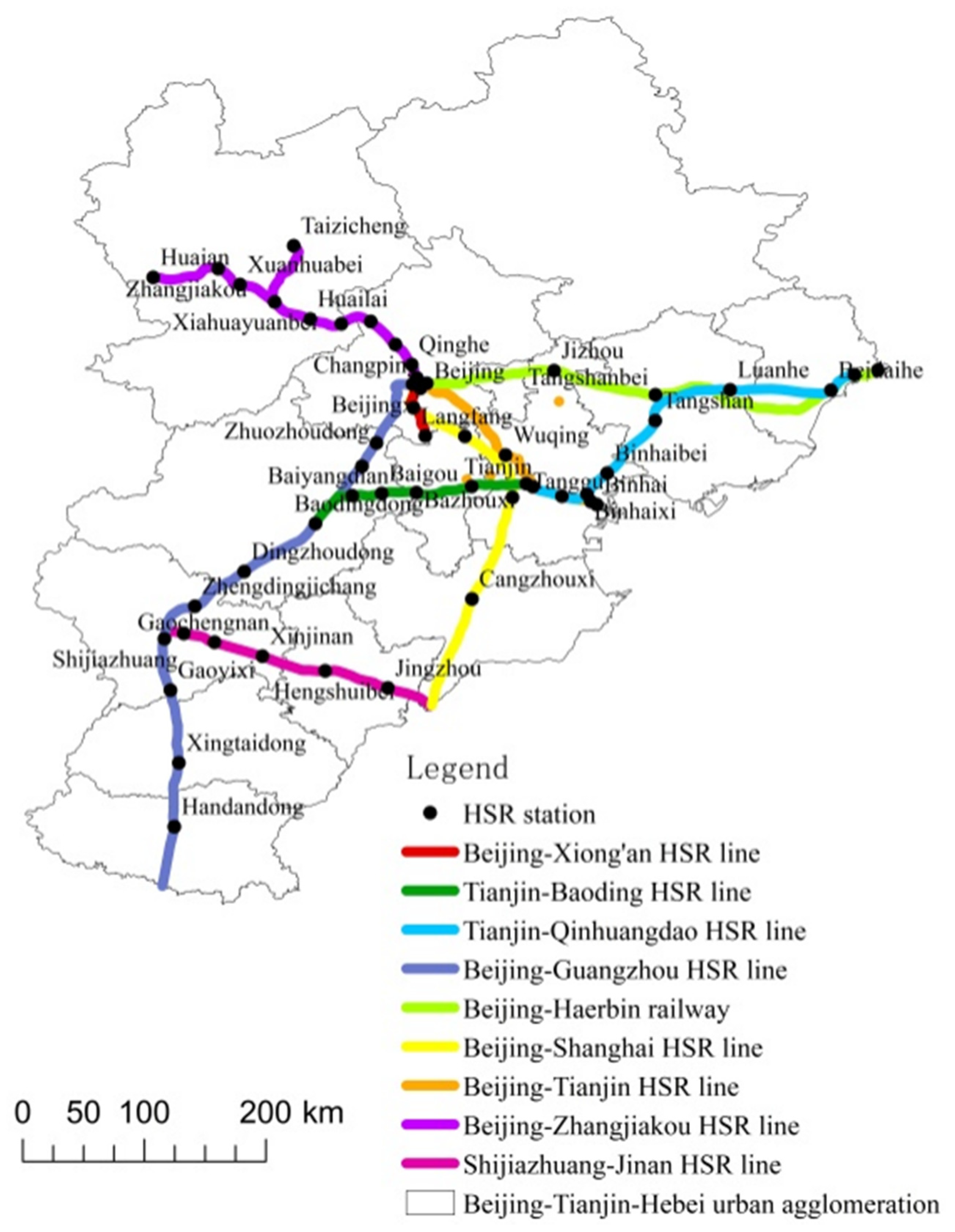
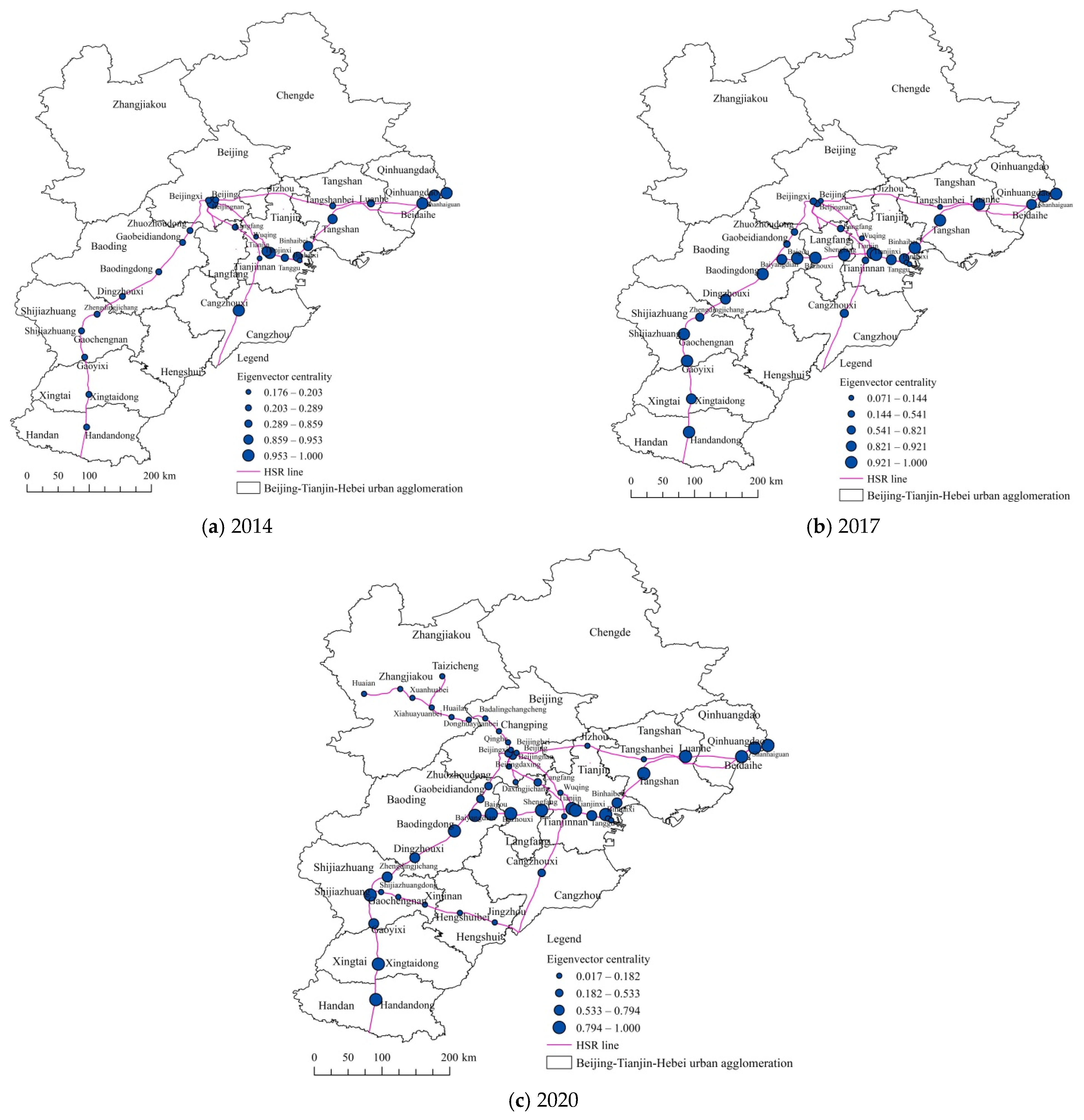
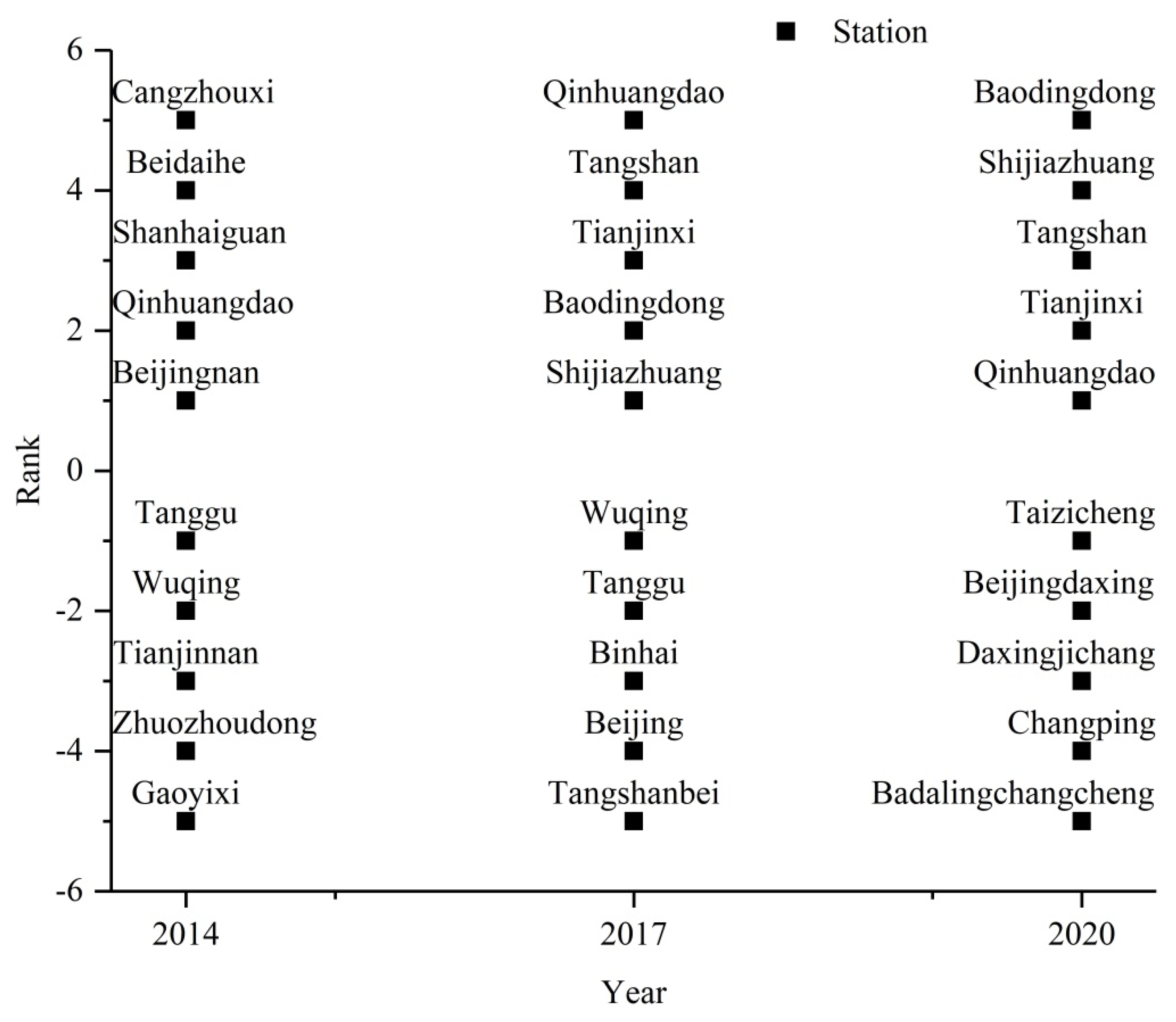

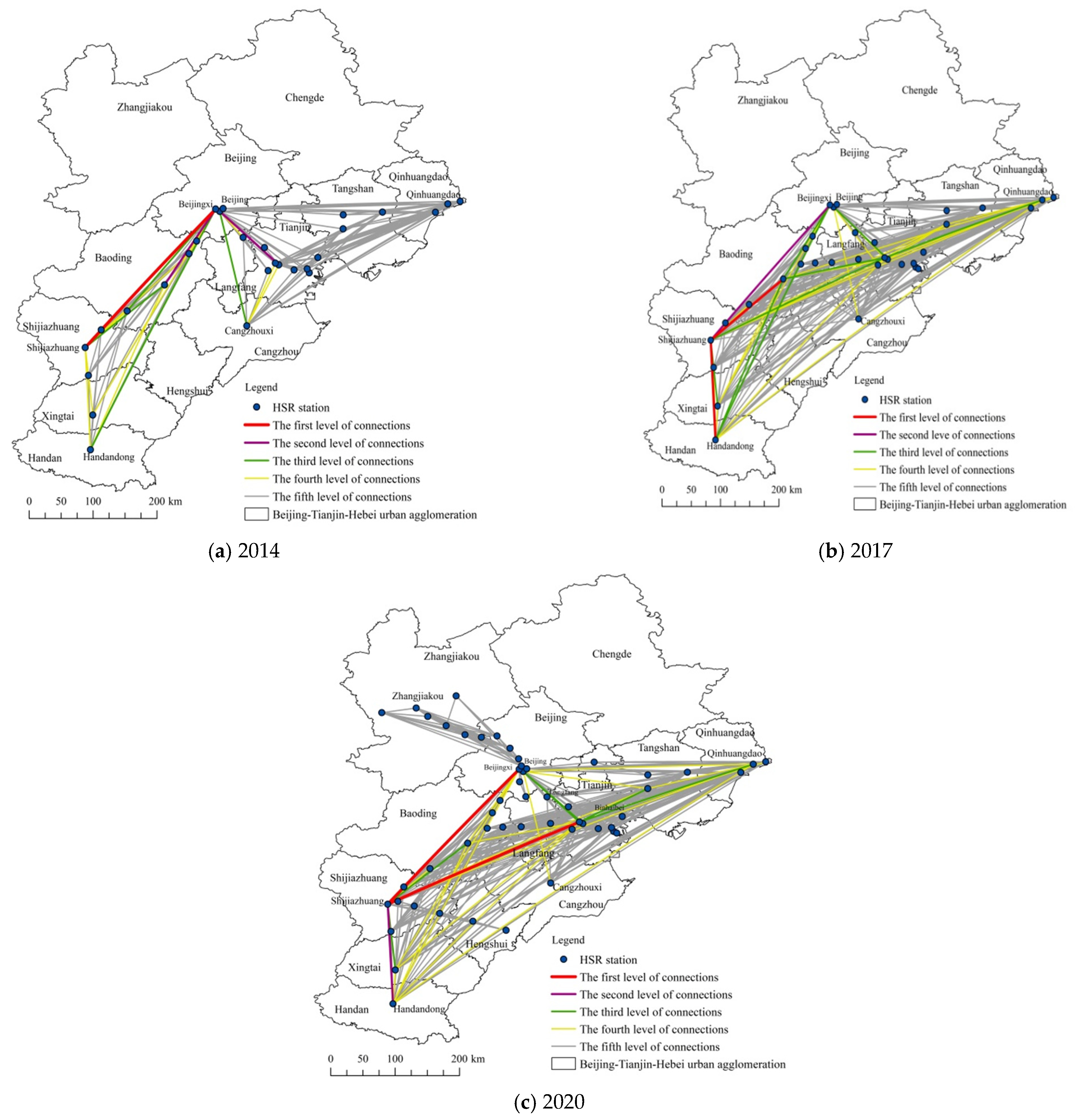
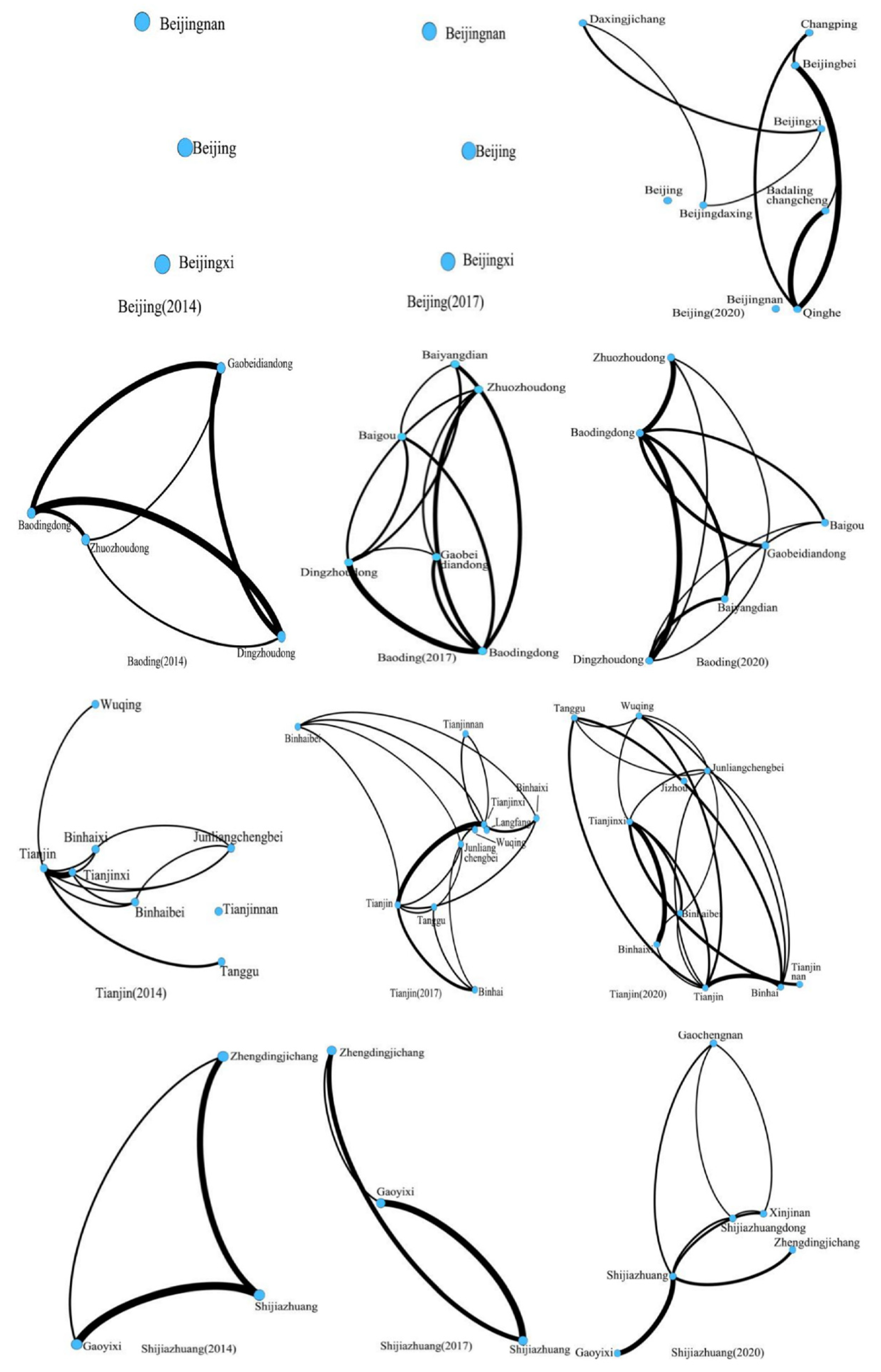

| Alighting Station Boarding Station | Station 1 | Station 2 | Station j | … | Station n |
|---|---|---|---|---|---|
| Station 1 | 0 | v1,2 | v1,j | … | v1,n |
| Station 2 | 0 | 0 | v2,j | … | v2,n |
| Station i | 0 | 0 | vi,j | … | vi,n |
| … | … | … | … | … | … |
| Station n | 0 | 0 | 0 | … | 0 |
Publisher’s Note: MDPI stays neutral with regard to jurisdictional claims in published maps and institutional affiliations. |
© 2021 by the authors. Licensee MDPI, Basel, Switzerland. This article is an open access article distributed under the terms and conditions of the Creative Commons Attribution (CC BY) license (https://creativecommons.org/licenses/by/4.0/).
Share and Cite
He, D.; Chen, Z.; Pei, T.; Zhou, J. The Regional and Local Scale Evolution of the Spatial Structure of High-Speed Railway Networks—A Case Study Focused on Beijing-Tianjin-Hebei Urban Agglomeration. ISPRS Int. J. Geo-Inf. 2021, 10, 543. https://doi.org/10.3390/ijgi10080543
He D, Chen Z, Pei T, Zhou J. The Regional and Local Scale Evolution of the Spatial Structure of High-Speed Railway Networks—A Case Study Focused on Beijing-Tianjin-Hebei Urban Agglomeration. ISPRS International Journal of Geo-Information. 2021; 10(8):543. https://doi.org/10.3390/ijgi10080543
Chicago/Turabian StyleHe, Dan, Zixuan Chen, Tao Pei, and Jing Zhou. 2021. "The Regional and Local Scale Evolution of the Spatial Structure of High-Speed Railway Networks—A Case Study Focused on Beijing-Tianjin-Hebei Urban Agglomeration" ISPRS International Journal of Geo-Information 10, no. 8: 543. https://doi.org/10.3390/ijgi10080543
APA StyleHe, D., Chen, Z., Pei, T., & Zhou, J. (2021). The Regional and Local Scale Evolution of the Spatial Structure of High-Speed Railway Networks—A Case Study Focused on Beijing-Tianjin-Hebei Urban Agglomeration. ISPRS International Journal of Geo-Information, 10(8), 543. https://doi.org/10.3390/ijgi10080543







